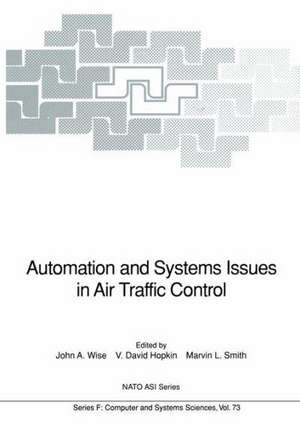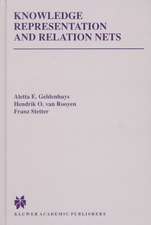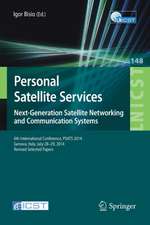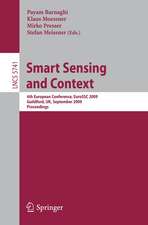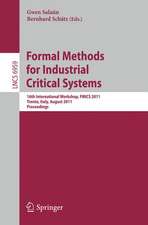Automation and Systems Issues in Air Traffic Control: NATO ASI Subseries F:, cartea 73
Editat de John A. Wise, V. David Hopkin, Marvin L. Smithen Limba Engleză Paperback – 23 dec 2011
Din seria NATO ASI Subseries F:
- 20%
 Preț: 650.27 lei
Preț: 650.27 lei - 20%
 Preț: 668.55 lei
Preț: 668.55 lei - 20%
 Preț: 992.44 lei
Preț: 992.44 lei - 18%
 Preț: 1239.19 lei
Preț: 1239.19 lei - 20%
 Preț: 1922.81 lei
Preț: 1922.81 lei - 20%
 Preț: 654.37 lei
Preț: 654.37 lei - 18%
 Preț: 1234.00 lei
Preț: 1234.00 lei - 20%
 Preț: 709.78 lei
Preț: 709.78 lei - 20%
 Preț: 656.03 lei
Preț: 656.03 lei - 18%
 Preț: 1854.94 lei
Preț: 1854.94 lei - 20%
 Preț: 374.97 lei
Preț: 374.97 lei - 20%
 Preț: 991.94 lei
Preț: 991.94 lei - 20%
 Preț: 671.02 lei
Preț: 671.02 lei - 20%
 Preț: 1925.96 lei
Preț: 1925.96 lei - 20%
 Preț: 994.73 lei
Preț: 994.73 lei -
 Preț: 389.49 lei
Preț: 389.49 lei - 20%
 Preț: 657.99 lei
Preț: 657.99 lei - 20%
 Preț: 655.20 lei
Preț: 655.20 lei - 18%
 Preț: 1225.31 lei
Preț: 1225.31 lei - 18%
 Preț: 952.09 lei
Preț: 952.09 lei - 20%
 Preț: 332.06 lei
Preț: 332.06 lei - 20%
 Preț: 1284.47 lei
Preț: 1284.47 lei - 20%
 Preț: 644.81 lei
Preț: 644.81 lei -
 Preț: 395.85 lei
Preț: 395.85 lei - 18%
 Preț: 1221.07 lei
Preț: 1221.07 lei - 15%
 Preț: 643.34 lei
Preț: 643.34 lei - 20%
 Preț: 645.47 lei
Preț: 645.47 lei - 20%
 Preț: 1282.98 lei
Preț: 1282.98 lei - 20%
 Preț: 656.36 lei
Preț: 656.36 lei - 20%
 Preț: 1283.31 lei
Preț: 1283.31 lei - 20%
 Preț: 1924.15 lei
Preț: 1924.15 lei - 20%
 Preț: 362.24 lei
Preț: 362.24 lei
Preț: 665.75 lei
Preț vechi: 832.19 lei
-20% Nou
Puncte Express: 999
Preț estimativ în valută:
127.39€ • 133.36$ • 105.41£
127.39€ • 133.36$ • 105.41£
Carte tipărită la comandă
Livrare economică 05-19 aprilie
Preluare comenzi: 021 569.72.76
Specificații
ISBN-13: 9783642765582
ISBN-10: 3642765580
Pagini: 622
Ilustrații: XIX, 593 p.
Dimensiuni: 170 x 242 x 33 mm
Greutate: 0.98 kg
Ediția:Softcover reprint of the original 1st ed. 1991
Editura: Springer Berlin, Heidelberg
Colecția Springer
Seria NATO ASI Subseries F:
Locul publicării:Berlin, Heidelberg, Germany
ISBN-10: 3642765580
Pagini: 622
Ilustrații: XIX, 593 p.
Dimensiuni: 170 x 242 x 33 mm
Greutate: 0.98 kg
Ediția:Softcover reprint of the original 1st ed. 1991
Editura: Springer Berlin, Heidelberg
Colecția Springer
Seria NATO ASI Subseries F:
Locul publicării:Berlin, Heidelberg, Germany
Public țintă
ResearchCuprins
The Impact of Automation on Air Traffic Control Systems.- Assumptions and Automation in Air Traffic Systems.- Perspectives on Air Traffic Control Automation.- Computerization and Automation: Upgrading the American Air Traffic Control System.- The Canadian Automated Air Traffic System (CAATS): An Overview.- The Implementation and Impact of Automatic Data Processing on UK Military ATC Operations.- From Under the Headset: The Role of the Air Traffic Controllers’ Professional Association in Present and Future Air Traffic Control Systems Development.- A Collation of Approaches to Systems.- Air Traffic Control and Systems Issues.- ICAO and Future Air Navigation Systems.- Social, Political, and Regulatory Issues Concerning Harmonization of Interacting Air Traffic Control Systems in Western Europe.- Aircraft Traffic Forecast and Communications Requirements in the Year 2000.- Automation in Environmental Engineering.- The Role of Automation and Control Systems in Water Resources Engineering.- Automated Aids and Their Evaluation.- Intelligent Dialogue in Air Traffic Control Systems.- Close Ground/Air Cooperation in Dynamic Air Traffic Management.- Multi-layer Queuing Model to Check Automated Air Traffic Control Systems.- Application of Planning Aids for Air Traffic Control: Design Principles, Solutions, Results.- Artificial Intelligence and Human Factors in ATC: Current Activity at Eurocontrol Experimental Centre.- Meeting the ATC Challenge through Simulation.- Human Attributes, Representatives, and Requirements in Relation to Automation.- The Aims of Human Factors and Their Application to Issues in Automation and Air Traffic Control.- Human Factors in System Design.- Automated Systems: The Human Factor.- Modelling Control Tasks in Complex Systems.- Mental Models in Air TrafficControl.- The Controller in Human Engineering.- Acceptance of New Systems by Air Traffic Controllers.- Effects of the System on the Human: Stress and Workload.- Stress and Workload Management in Air Traffic Control.- Shiftwork and Circadian Variations of Vigilance and Performance.- Operator Workload as a Limiting Factor in Complex Systems.- Attention, Workload, and Automation.- Approaches to Error and Failure.- ICAO and Civil/Military Coordination.- Error Models for Operating Irregularities: Implications for Automation.- Cognitive Failures in Military Air Traffic Control.- Human Factors in ATC Communication.- Results of a Perceptual Study on Human Error in Computer Systems Based on Bailey’s Research.- Organizational and Cultural Aspects of Air Traffic Control Automation.- Automation, Information, and Consciousness in Air Traffic Control.- Issues in Cultural Ergonomics.- Air Traffic Controller Working Conditions and Organization: Suggestions for Analysis and Improvements from a Psychological Point of View.- Automation as an Influence on Controller Selection.- Selecting for Air Traffic Control: The State of the Art.- Selection of Air Traffic Controllers for Automated Systems: Applications from Today’s Research.- Automation Issues for the Selection of Controllers.- Automation in ATC: How Does It Affect the Selection of Controllers?.- Consequences of Automation for Training and Resource Management.- Training Requirements for Automated ATC.- Adaptive Training to Accommodate Automation in the Air Traffic Control System.- Resource Management Training for Air Traffic Controllers.- Non-Technical Training for Technocrats: Resource Management at Canadian Airlines.- Critical Issues for Decision Makers in Providing Operator and Maintainer Training for Advanced Air TrafficControl Systems.- Speculations on Automation and Air Traffic Control.- A Modest Proposal for Future Systems.- The Blue Sky Challenge: A Personal View.- Automation and Systems Issues in Air Traffic Control: Blue Sky Concepts.- What If... We Integrated Both Training and Monitoring Functions into Air Traffic Control Workstations?.- Some Final Thoughts.- Closing Remarks.- Anyone at Home?.- Participants.- Photographs of Air Traffic Control Facilities.- Index and Glossary.
